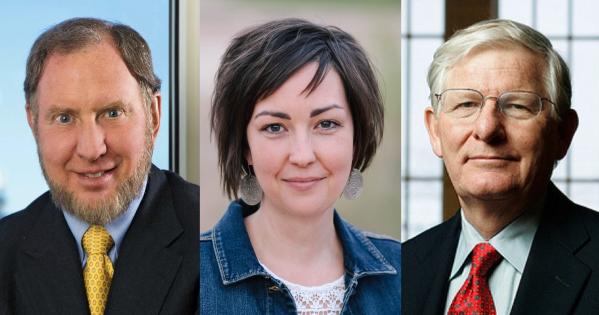Can Today’s Polarized America Come Together Again?

American history is marked by centuries of tension between individualism and the common good. On March 24, SPA Distinguished Professor James Thurber led a discussion on the conditions that trigger community-minded periods, and whether another is on the horizon.
Robert Putnam and Shaylyn Romney Garrett, authors of The Upswing: How America Came Together a Century Ago and How We Can Do It Again (Simon & Schuster, 2020) were the featured guests in the final of a series of James A. Thurber Dialogues on America. The event was co-hosted by the AU School of Public Affairs (SPA) Center for Congressional and Presidential Studies, the Kennedy Political Union, and the United States Capitol Historical Society.
The book examines trends in economic inequality, political partisanship, social capital, and cultural narcissism. The authors reveal waves of individualism and communitarianism that they call “I-we-I” curves. In the late 19th century, the Gilded Age ushered in big gaps between rich and poor, followed by the Progressive Era, which brought decades of improvements to equality that lasted until the 1960s. Since then, growing income inequality and political polarization have led up to the present moment, which Putnam suggests rivals that of Civil War times.
The researchers performed an extensive data analysis to unpack these trends; results suggested forces beyond the impact of the Great Depression or the World Wars. Garrett, a writer and entrepreneur, referred back to lessons from the Progressive Era, when citizens looked beyond partisanship to push for child labor laws, trust busting, consumer protections, and voting rights for women.
“It was a movement that brought in people of all different stripes,” Garrett said. “What really brought these Progressives together was a compelling desire to repudiate the multi-dimensional crisis in which they found themselves, and a galvanizing belief in the power of ordinary citizens to do so.”
These changing attitudes, rather than efforts to address economic inequality, triggered reforms.
“When the culture of the Gilded Age, the social Darwinism of that period, was really called into question, you had reformers coming on the scene,” Garrett says. “The Progressive Era was a rethinking of our nation's values., and a reevaluating of the place of communitarianism relative to individualism. We think that's likely going to be what we'll need to see today. There are lots of lessons, but I think that's one of the most thought-provoking ones: it seems like culture led.”
Putman, a Harvard professor of public policy and former dean of the Kennedy School of Government, suggested that a more cooperative society will come from people finding common interests at the local and state level, prompting a moral reawakening. He sees hope for such a resurgence of community at the current moment, with young activists leading on environmental, gun control, and racial justice issues.
“It will happen, we think, again, if large numbers of young people in America forgo the cynicism that they're perfectly entitled to,” said Putman. “The last time we went through this, young people took it upon themselves to have a moral inflection to their concerns, and then to carry those into practice in many grassroots ways. I'm actually very encouraged by the fact that right now a lot of the reform movements around the world are led by young people.”
